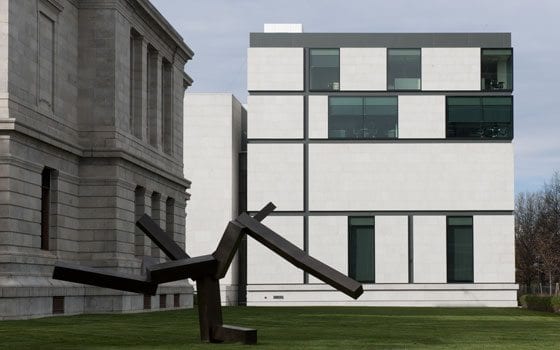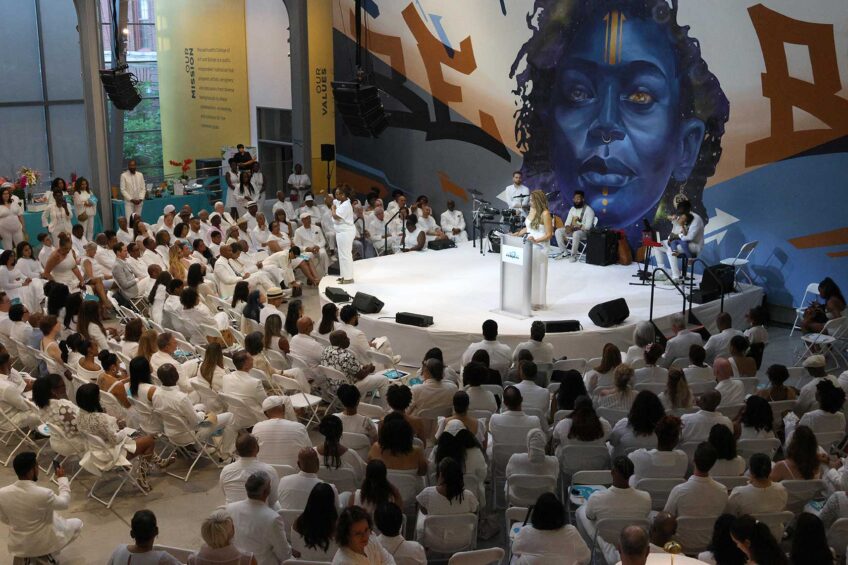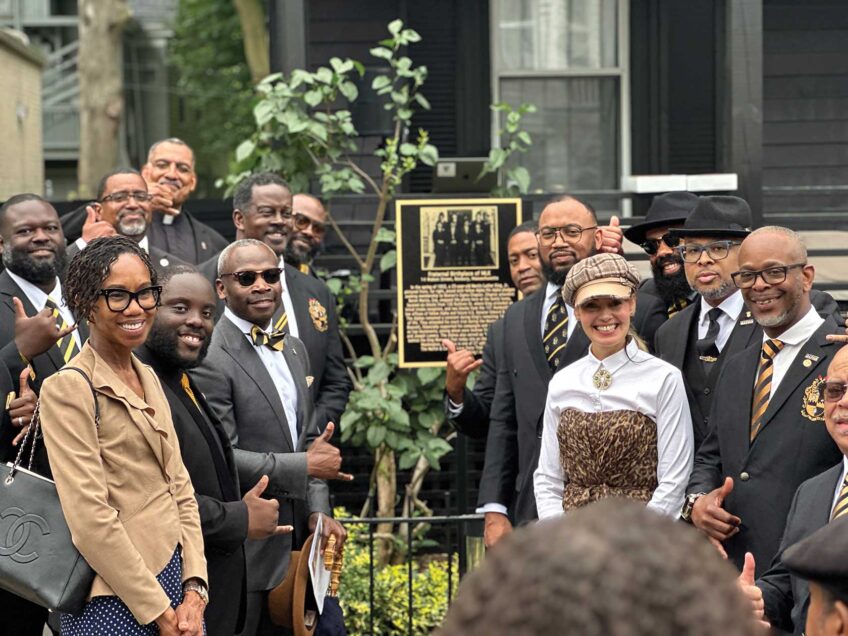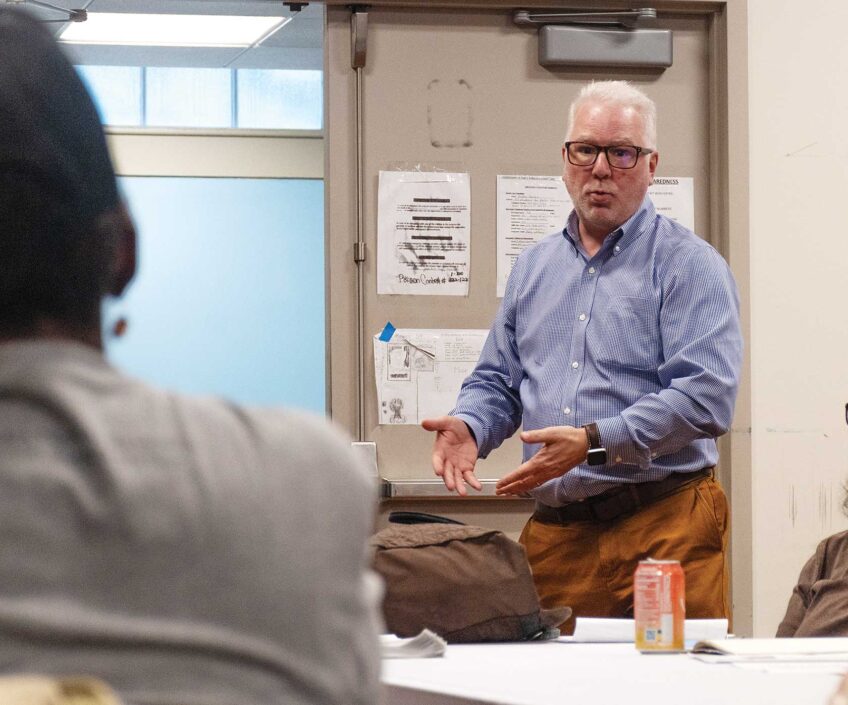

The Museum of Fine Arts Boston (MFA) will open its newest wing to the public this Saturday with a free community day. The Art of the Americas wing almost doubles the size of the MFA. (
On Saturday, Nov. 20, the Museum of Fine Arts Boston (MFA) opens its new wing for the Art of the Americas to the public with a free community day. From 10 a.m. to 9:45 p.m., visitors can enjoy music, festivities and guided tours of the dazzling $345 million structure.
The new wing equips the MFA to do what no other major museum has attempted: To bring together the arts of all the Americas — North, South and Central — and explore the continent’s rich cultural and artistic diversity.
Designed by the London architects Foster and Partners in collaboration with MFA curators, the 121,307-square-foot wing will enable the museum to capitalize on its collection and interweave multiple artistic threads from the tip of Greenland down to Cape Horn.
“Visitors will be able to appreciate the MFA’s extraordinary collections in new and exciting ways,” says Ann and Graham Gund Director Malcolm Rogers. “These beautifully designed spaces enrich the visitor experience and set a dramatic stage for the Museum’s Art of the Americas collections in a unique setting — Boston — where much of this country’s history took shape.”
Concluding five years of construction and 11 years of planning, preparation and fundraising, the new, east-facing wing is faithful to the original design of Guy Lowell, the architect of the MFA’s 1909 Beaux Arts building. He envisioned the museum’s north-south axis between its Fenway and Huntington Avenue entrances as a way to connect the museum to Frederick Law Olmsted’s Emerald Necklace and the heart of the city.
Like the façade of the 1909 building that surrounds it on two sides, the new wing is clad in granite from Deer Isle, Maine. Its interior is grand and inviting at the same time. Sunlight streams into its 63-foot-high, 12,000-square-foot courtyard, which is walled by glass on two sides.
The courtyard leads to the above-ground galleries, housed in a stack of three pavilions fronted with ivory limestone, a glass central core and a staircase.
Increasing gallery space for the Art of Americas by 42 percent, the new wing enables the department to display more than 5,000 objects, about 30 percent of the collection — twice the number previously on view.
Built to accommodate works of all sizes, the galleries are about 16 feet high. Designed to encourage discovery and reflection, the exhibition areas include four “behind-the-scenes” study centers and seating areas with commanding views of the Boston skyline and Fens parkland.
Elliot Bostwick Davis, chair of the Art of the Americas department, led the curators in planning and installing the new wing. Many of the 53 galleries mingle objects from traditionally separate disciplines — painting, sculpture, works on paper, furniture (including nine fully furnished period rooms), musical instruments, decorative arts and textiles.
The wing displays the collections on four levels that ascend in chronological order from prehistory to the third quarter of the 20th century. On each level, a central gallery displays iconic works, and adjacent galleries explore artists, preoccupations and styles of the period.
Ancient American, Native North American and 17th-century collections are located on the lower ground level. Works of 18th-century art from the Colonial period and early 19th-century are on Level 1; 19th and early 20th century art are displayed on Level 2; and 20th-century art is shown on Level 3.
Each level is spectacular in its own way.
On the third level, 20th-Century Art through the mid-1980s, natural light filters through louvered ceiling panels, illuminating the electrifying mid-century masterpieces of abstraction on view in its 22-foot-high central gallery. Accompanying large-scale works by such Americans as Mark Rothko, Morris Louis, and Joan Mitchell is Argentinean César Paternosto’s magnetic “Staccato” (1965). Sculptures on view include an Alexander Calder mobile and John Chamberlain’s iridescent mash-up of car parts, “Red Ryder” (1964). Complementing the pure plays of color and geometric form are Joseph Stella’s soaring “Old Brooklyn Bridge” (ca. 1941) and “The Deluge” (1969) a haunting landscape by Philip Guston.
An alluring exhibit of period furniture, jewelry and home décor shows how designers applied the biomorphic and geometric forms of abstract painting to objects of daily life.
Other galleries show an earlier generation of modernists. Drawing from the great Lane Collection of American Modernists, paintings and photography. A room with works by Georgia O’Keeffe, Charles Sheeler, Stuart Davis and Arthur Dove also shows Joseph Cornell’s small boxes of tiny, evocative objects next to a serene wave in stone, “Study in the Classical” by Isamu Noguchi (1958).
Alongside paintings of urban scenes by John Sloan and Edward Hopper is African American artist Allan Rohan Crite’s “Tire Jumping in Front of My Window” (1936, 1947), a lively rendering of his South End neighborhood.
Late 20th century depictions of the human figure include a strange image of a napping monk and a young boy by Claudio Bravo, “Vanitas” (1981) of Chile.
Conspicuously absent in this 20th century sampling were Andy Warhol and his Pop Art brethren; but perhaps they will be the focus of a future show.
On the second level is 19th-Century and Early 20th-Century Art. While showcasing a critical mass of some of the MFA’s defining treasures, this level’s galleries also offer joyous juxtapositions of styles and media.
Elegant damask wallpaper sets an opulent tone for a cluster of works by John Singer Sargent. For the first time since 1953, his iconic “The Daughters of Edward Darley Boit” (1882) is reunited with his portraits of their parents, Mr. and Mrs. Boit.
Adjacent galleries are devoted to works that look at America, including landscapes by Hudson River painters; Winslow Homer’s seascapes; and Martin Johnson Heade’s spare and sensuous miniatures of coastal New England.
A trio of exquisite stained glass panels by Louis Comfort Tiffany and John LaFarge leads into a group of galleries that show American painters exploring international trends, including Japanese art and European Impressionism. Childe Hassam endows a Parisian flavor to Boston in “Charles River and Beacon Hill” (ca. 1892); and “Boston Common at Twilight” (1885-6).
In fascinating contrast to the fine-art sobriety are exuberant galleries of folk art. Among the displays are two amazing, hand-crafted carousel figures from Rhode Island: a greyhound by Charles I.D. Looff and a hog by Salvatore Cernigliaro, both dated 1905.
Some works are classics by any standard, including the “Pictorial Quilt” (1895-98) by Georgian Harriet Powers. Born a slave, she gained renown for exuberant quilts depicting scenes of Bible stories and folk tales. Another famous work on view is the Edward Hicks painting “Peaceable Kingdom”(ca. 1844). In an unknown artist’s strange and captivating “Meditation by the Sea” (1860s), a tall, lone figure in a top hat gazes on stylized surf. “Boston Harbor” (ca. 1824) by Rufus Porter, shows a primeval scene of the harbor islands.
Delightful rivals to Sargent’s Boit daughters are “Three Sisters of the Copeland Family” (1854). Boston shopkeeper and abolitionist William Matthew Prior painted this vibrant close-up of the little girls, whose father was a prosperous African American businessman, Samuel Copeland.
Period furniture and musical instruments on view include an 1878 reed organ of walnut and rosewood from Brattleboro, Vt.; and the thickly carpeted parlor and dining room of the Roswell Gleason House in Dorchester, built in about 1840.
On the first floor is 18th-Century Art of the Colonial Americas and Early 19th-Century Art. Among the portraits of Boston patriots by John Singleton Copley is “Paul Revere” (1768), which shows the silversmith holding a glistening teapot. Nearby is “Sons of Liberty Bowl” (1768), Paul Revere’s tribute to the Massachusetts House of Representatives, who challenged British tax laws.
Monumental works on view include the billboard-size Thomas Sully painting, “The Passage of the Delaware” (1819) and other large-scale dramas such as Benjamin West’s “King Lear” (1788) and Copley’s “Watson and the Shark” (1778). Small-scale pleasures include Henry Sargent’s two views into the lifestyle of Boston’s prosperous merchant class: “The Tea Party” (ca. 1824) and “The Dinner Party” (ca. 1821).
New England “rural arts” — handcrafted furniture and decorative arts — are the subject of one gallery. Another shows the Spanish influences on the silver, textiles and portraiture of Central and South America. Also on display are the dining room, parlor and bedroom of an Salem trade baron’s daughter, whose home was a tour de force of period craftsmanship.
The floor that presents the earliest collections — Ancient American, Native American, and 17th-Century and Maritime Arts — is located on the wing’s lower ground level.
Many American odysseys began on ships, which transported explorers and conquerors, colonists and slaves, and, in the last century, tides of European immigrants to the New World. Maritime trade peaked in the 18th century and inspired its own genre of painting and craftwork. Many of the large, elaborate ship models on view include one of the USS Constitution, docked in Charlestown.
The works of indigenous peoples are also on display. Two galleries of ancient art from Mesoamerica (modern-day Mexico, Guatemala, Belize and Honduras) show objects from the most important collection of Mayan ceramics outside Guatemala, including massive burial urns (650-850 AD) from ancestral Mayans. Traditional and contemporary works from Native Americans include pottery and basketry as well as Eskimo scrimshaw.
Depicting New England life in the 17th- and early 18th-centuries are portraits, furniture, silver and domestic textiles. A fully equipped family room is on view, along with the oak and larchwood frame of an Ipswich house built in 1692.
Also on the lower level are a new, 150-seat auditorium, two studio arts classrooms, a seminar room and the new 8,300 square-foot Ann and Graham Gund Gallery, which will exhibit art of all kinds. On view until Feb. 13, 2011 is “Fresh Ink: Ten Takes on Contemporary Chinese Tradition,” which shows works by 10 Chinese artists in response to art in the museum’s collection. Jackson Pollock’s long horizontal drip painting “Number 10” (1949) is encased flat, like a scroll, next to an ink landscape by Arnold Chang. A six-panel ink rendering of clouds and ridges by Li Huayi hovers above the swirling Chen Rong composition, “Nine Dragons” (1244).
The next major milestone in the museum’s evolution is the September 2011 debut of the Linde Family Wing for Contemporary Art, which will occupy the former West Wing designed by I.M. Pei.
Meanwhile, on its eastern side, the MFA has created an elegant new wing that promises to transform the way we experience the art of America — and our city.
Before you go, visit: http://www.mfa.org/americas-wing.






